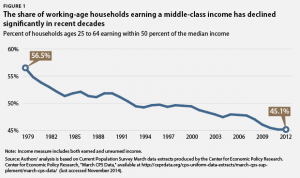 For many people working in the arts, the holidays can be extremely challenging. Many of us are on tight budgets, but we are bombarded with advertisements telling us that our rich emotional lives and spiritual connections are not enough – if we want to show people we care, we should be buying them stuff. Then, once we are finally done shopping, many of us must attend family gatherings where we know certain relatives will attack us for doing the work we love.
For many people working in the arts, the holidays can be extremely challenging. Many of us are on tight budgets, but we are bombarded with advertisements telling us that our rich emotional lives and spiritual connections are not enough – if we want to show people we care, we should be buying them stuff. Then, once we are finally done shopping, many of us must attend family gatherings where we know certain relatives will attack us for doing the work we love.
If you come from one of those rare families where everyone supports you in your arts career, then you can skip the rest of this column. But for those of you who may need to defend yourselves at holiday gatherings, WomenArts has compiled a list of responses to four of the most annoying questions/comments that artists are likely to hear. Please let us know if there are others you would like us to address in future columns.
No matter what anyone says to you, we hope you know that we love artists here at WomenArts. We think your work is essential, and we hope you have the best holiday season ever!
Martha Richards, Executive Director, WomenArts
1) WHEN ARE YOU GOING TO GET A REAL JOB?
It used to be possible for artists to sacrifice everything they loved to get a boring but stable job that would provide enough income to support a family, as well as health insurance and a pension. But it’s a lot harder to live that life of quiet desperation these days.
 The truth is that there are not many “real jobs” left that can provide the stability and benefits that previous generations had. The middle class is shrinking and two-thirds of Americans are living paycheck to paycheck. Most could lose their jobs at any time. Many of the old jobs have been outsourced to other countries or automated out of existence. As the gap widens between the rich and the poor, job insecurity is a growing problem for millions of Americans.
The truth is that there are not many “real jobs” left that can provide the stability and benefits that previous generations had. The middle class is shrinking and two-thirds of Americans are living paycheck to paycheck. Most could lose their jobs at any time. Many of the old jobs have been outsourced to other countries or automated out of existence. As the gap widens between the rich and the poor, job insecurity is a growing problem for millions of Americans.
We desperately need imagination, inspiration and innovation to find our way out of this mess. Instead of telling artists to chase after non-existent “real jobs,” we should be encouraging them to focus their creativity on the real work that needs to be done, i.e. helping us find ways to live in harmony with each other and with Mother Nature. As recent events have shown, that work is far more urgent than any other task.
2) ARTISTS ARE SO SELF-CENTERED.
Are artists really more self-centered than people in other professions? What about the investment bankers who have destroyed our economy, the real estate speculators who are driving up home prices, the oil tycoons who are wrecking the environment, or the billionaires trying to control our political system?
Trampling on other people and destroying the planet so that you can make money is self-centered. How many artists are guilty of that?
In fact, most artists are much more focused on giving than taking. They look deeply inside themselves in order to find something beautiful to share with the world, and their best creations will inspire people for generations. The world would be a much better place if more people gave as much to their communities as artists do.
3) THE ARTS ARE ONLY FOR RICH PEOPLE.
Actually, the urge to create is a basic human instinct. The cave men and women drew pictures on the walls of their caves, and throughout history people have written, performed, and created visual art. In our own times, millions of people share pictures and music over the Internet every day. Almost everyone has a favorite song, film, or television program, and almost everyone engages with some form of art every day.
The perception that the arts are for the rich stems from the fact that tickets are often so expensive at our major arts institutions. In other countries, people can afford to go to the theatre, ballet and even the opera. The reason is that many other countries provide much more arts support than we do because they cherish the arts as a human birthright that needs to be protected and celebrated. For instance, the German government provides over 40 times as much art support per capita as the U.S. government does. When arts organizations have enough government support, they can keep their ticket prices lower so that more people can afford them.
When the National Endowment for the Arts was created in 1966, everyone hoped that the U.S. government would finally join other civilized countries in making the arts accessible to all. But the National Endowment for the Arts has been under constant right-wing attack ever since President Reagan put it on the chopping block shortly after he was elected in 1980.
As a result, the NEA budget has been frozen for decades. Its 2015 budget allocation was $146 million. That is $16 million LESS than its 1984 budget of $162 million. For contrast, the National Science Foundation’s budget is $7 billion a year, and our 2015 military budget is $598 billion.
To reclaim the arts for the general public and not just the wealthy, we need to persuade our legislators to take away 1% of the military budget and give it to the arts. Think about what we could do with that $6 billion! Arts organizations all over the country could offer free performances, screenings, exhibits, and educational activities. Everyone would be able to attend whatever they wanted.
That cultural freedom would have a profound effect on all of our lives. In fact, if we made a substantial investment in arts projects that were designed to build cross-cultural and cross-class understanding, it would probably go a long way towards breaking down some of the persistent race and class barriers in our country.
4) ALL THOSE ARTS GROUPS DO IS BEG, BEG, BEG!!!
It is true that non-profit organizations deluge the public with solicitations at this time of year. The reason is that they are trapped in a terribly inefficient fundraising system that burns out their staff members and annoys their donors.
Back in the day when more government funding was available for the arts, a grant-writer for a large arts organization might spend a week or two creating a strong proposal, and then they could get a grant of $10,000 or more. But these days those larger grants are few and far between.
To replace one $10,000 grant with small donations from individuals, the non-profit has to find hundreds of donors, and that is a very expensive and labor-intensive process. Instead of one grant-writer, the non-profit needs a whole team of people to write and distribute solicitation letters, to create an email and social media campaign, and to organize fundraising parties and follow-up calls. Many small non-profits can’t compete because they don’t have the staff to do this extra work. Also, as more and more non-profits struggle to find funds, the potential donors get overwhelmed with requests and become less responsive, and so the non-profits must re-double their efforts to woo them back. This means that the non-profits have to run faster every year just to stay in place.
This system is nuts and needs to be changed. We are wasting everyone’s time and resources by making non-profits chase individual donors one-by-one instead of having a fair and orderly system where people pay their taxes and then government agencies distribute the funds to worthy organizations. If you want fewer fundraising letters in your mailbox, it is time to tell your legislators that you want a government that supports essential public services like the arts and education.
Thanks so much to Robert Reich and our friends at Moveon.org for inspiring this blog with their excellent video, Your Holiday Guide to Dealing with Uncle Bob.
We hope this blog is helpful to you at holiday gatherings this year. Please feel free to send us your comments. If you would like to support WomenArts, you can click here or click on the Donate Now! button in the top right section of any page on this website. Thank you!

